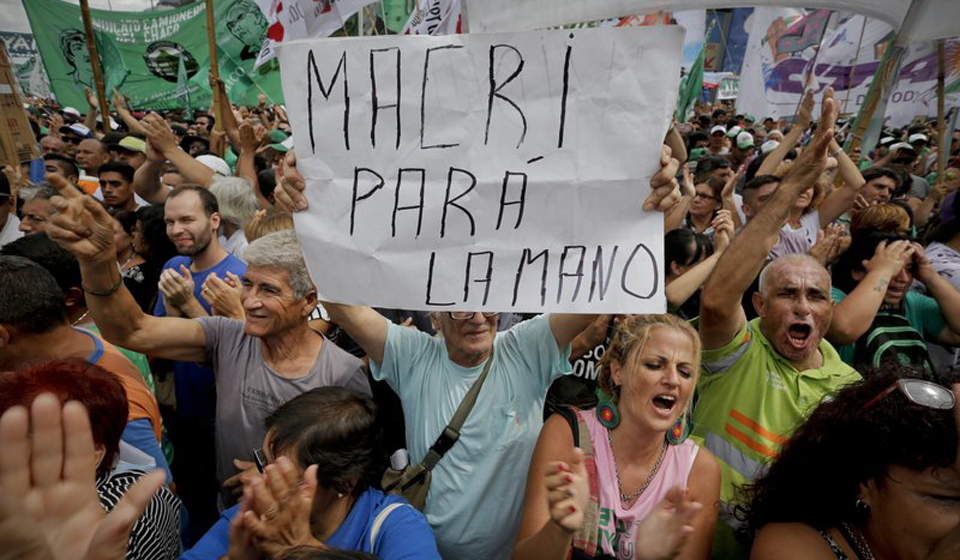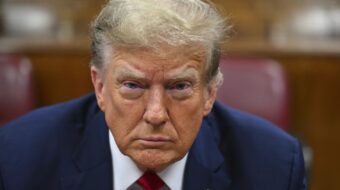
Workers and their unions in Argentina are mounting an ever more united fight against the neoliberal policies of right wing President Mauricio Macri. What remains to be seen is if these protests, and the public discontent they reflect, will have an impact on Argentina’s next presidential and general elections, scheduled for October of 2019.
Macri, from the right wing Republican Proposal and “Let’s Change” coalition, won a narrow victory in the last elections, held on October 25 of 2015, over Peronist, left (including Communist Party) and center candidate Daniel Scioli, with a margin of only 2.68 percentage points. In spite of not having a majority in the Argentine Congress, Macri immediately began to implement a radical neo-liberal program which has undermined the position of the Argentine working class while favoring the rich and the multinational corporations. As is usual in these situations, the reason given is to “attract foreign investment” and lower the price of Argentine exports, making them more attractive on the international markets.
First came massive layoffs of public and private sector workers, plus sharp cuts in the government subsidies that had made life tolerable for many lower income Argentines. These measures were sometimes imposed by emergency executive order. Between December of 2015 and the summer of last year when some 264, 000 Argentines lost their jobs. With deregulation and the elimination of subsidies, electrical rates shot up. A devaluation of the currency led to a sharp increase in food prices. Basic public services are being gutted.
As a result of these anti-worker measures, some 1.8 million Argentines were reduced to poverty, and some 750, 000 to extreme poverty in the first year and a half of Macri’s government. This has constituted a massive rollback of pro-worker policies carried out by Macri’s two predecessors, Cristina Fernandez de Kirchner (2007-2015) and Nestor Kirchner (2003-2007).
In addition to the right wing economic policies, the Macri government showed signs of wanting to use repressive measures against the opposition, including ex-president Cristina Fernandez de Kirchner and others.
In spite of mounting popular protests against the austerity measures, Macri’s allies managed to gain seats in the legislative elections held on October 22 last year. Although those elections were for only 127 of the 257 seats in the Chamber of Deputies, they were nevertheless a disappointment for the anti-Macri forces, which had hoped for a sweeping electoral defeat for the right wing government and its policies, but instead suffered some setbacks. But Macri still does not have a legislative majority in either house of the legislature. Macri’s “Let’s Change” bloc has only 108 deputies in the House, to 68 for the left-center and Peronist “Victory Front,” with other opposition groups making up most of the difference. In the Senate, the “Victory Front” has 36 of the 72 seats, exactly half. So the opposition definitely has potential leverage.
This is the context of the massive labor-led protests against the Macri government that have been ongoing, but reached a high point on February 21 of this year.
The February 21 protest was initiated by the transport workers’ union (National Federation of Truck Drivers), but quickly supported by most of Argentina’s fractious and often divided labor movement. The demands of the demonstration were for a general rollback of all the anti-worker policies instituted by Macri, but because the head of the transport union, Hugo Moyano, is controversial and is currently being investigated for alleged corrupt practices (a frame-up effort according to some) the right wing media in Argentina tried to portray the demonstration as being engineered by Moyano to defend his own position, at the cost of gumming up traffic for his own selfish ends. Some government supporters alleged beforehand that only a “handful” of organizations would support the event, but in fact it generated widespread support in the Buenos Aires area from the general public, and scores of different unions and other organizations participated. These included unions and union federations such as the Workers’ Central of Argentina and the Federal Workers’ Current, whose member unions represent public service workers. Many other social justice organizations also participated. The mobilization was vast, encompassing hundreds of thousands of workers and filling major public squares to above capacity.
In coming weeks, more actions are planned. For example, unions are complaining that the government is now cutting back sharply its investments in worker training and employment, and support for workers’ coops. The Workers Central of Argentina, the National Confederation of Work Cooperatives and the Milagro Sala Front for Jobs and Dignity issued a protest statement on March 1 sharply denouncing these new anti-worker moves, accusing the government of wanting “an Argentina without jobs” and calling for further protests.
So the mobilizations and protests will continue into the fall election season. It is assumed that Macri will run for reelection (permitted in Argentina) but who will oppose him is yet to be resolved. The unity and the strength of the movement for economic and social justice will have to continue to grow if the damage inflicted by Macri is to be reversed.
One thing that has historically been a big problem in Argentina is the disunity within the labor movement itself. To solve this, the Communist Party of Argentina is calling for a complete overhaul of the way organized labor functions. There is a crying need, says the Communist Party, to get away from the “corporatist” model by which unions function. This negative style of work began in the 1940s under the regime of President Juan Perón, whereby unions functioned as intermediaries between the workers on the one hand and the government and employers on the other.
Communists say it is necessary to return to a united model of class struggle unionism, democratically organized and without bureaucratic abuses. “We point out the need to immediately give concrete and immediate form….to a coordinating center” to make possible united action such as a 24-hour general strike, effective in the whole country, in the near future,” the party said in a statement. Such a new level of unity would allow the Argentine working class to achieve a level of people’s power to fight for social justice and national sovereignty in the face of capitalism and imperialism.












Comments